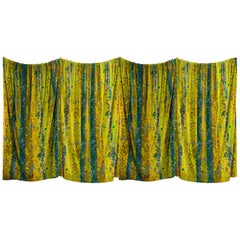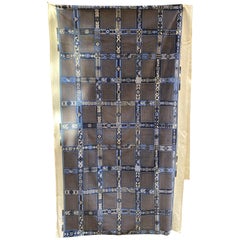Larsen Velvet Curtains
Recent Sales
Vintage 1960s American Mid-Century Modern Curtains and Valances
Fabric, Velvet
Vintage 1960s American Mid-Century Modern Curtains and Valances
Fabric, Velvet
Jack Lenor Larsen for sale on 1stDibs
Jack Lenor Larsen was a celebrated American mid-century modern textile designer born in Seattle. He fostered connections throughout the design and architecture industries beginning in 1950, and today, his influential eponymous design company is widely recognized for its muted hand-spun textured textiles. Larsen manufactured fabrics all over the world for more than six decades, using both traditional and modern weaving techniques.
Larsen initially studied in the architecture program at the University of Washington before he quickly realized he was instead interested in furniture design and interiors. He earned his MFA in 1949 from the Cranbrook Academy of Art — the go-to art school for design stars of the mid-20th century. The following year he moved and opened a studio in New York City where he launched his career.
For one of his first commissions, which was to design curtains for the Lever House — a New York City icon designed by Gordon Bunshaft and Natalie de Blois — Larsen created a linen and gold metal-themed weave to complement the building’s famed glass walls. He designed similarly magnificent textiles for the Phoenix Opera House, the Wolf Trap Theater and more.
Nowhere is Larsen’s profound impact on textile design more evident than at LongHouse Reserve, his house in East Hampton, New York. Modeled after a seventh-century Shinto Shrine, the home and its surrounding sculpture gardens opened to the public in 1992.
Larsen built LongHouse Reserve in collaboration with Charles Forberg. The property features sliding panels that showcase the revered artisan’s fabrics as well as works by Lucie Rie, Wharton Esherick, and Edward Wormley. The gardens feature sculptures by Willem de Kooning, Sol LeWitt and Yoko Ono.
Larsen had a solo exhibit at the Louvre in 1981. His work is held in the permanent collections of the Museum of Modern Art in New York, the Art Institute of Chicago and the Victoria and Albert Museum in London.
Find vintage Jack Lenor Larsen lounge chairs, sofas, and dining room chairs on 1stDibs.
A Close Look at mid-century-modern Furniture
Organically shaped, clean-lined and elegantly simple are three terms that well describe vintage mid-century modern furniture. The style, which emerged primarily in the years following World War II, is characterized by pieces that were conceived and made in an energetic, optimistic spirit by creators who believed that good design was an essential part of good living.
ORIGINS OF MID-CENTURY MODERN FURNITURE DESIGN
- Emerged during the mid-20th century
- Informed by European modernism, Bauhaus, International style, Scandinavian modernism and Frank Lloyd Wright’s architecture
- A heyday of innovation in postwar America
- Experimentation with new ideas, new materials and new forms flourished in Scandinavia, Italy, the former Czechoslovakia and elsewhere in Europe
CHARACTERISTICS OF MID-CENTURY MODERN FURNITURE DESIGN
- Simplicity, organic forms, clean lines
- A blend of neutral and bold Pop art colors
- Use of natural and man-made materials — alluring woods such as teak, rosewood and oak; steel, fiberglass and molded plywood
- Light-filled spaces with colorful upholstery
- Glass walls and an emphasis on the outdoors
- Promotion of functionality
MID-CENTURY MODERN FURNITURE DESIGNERS TO KNOW
- Charles and Ray Eames
- Eero Saarinen
- Milo Baughman
- Florence Knoll
- Harry Bertoia
- Isamu Noguchi
- George Nelson
- Danish modernists Hans Wegner and Arne Jacobsen, whose emphasis on natural materials and craftsmanship influenced American designers and vice versa
ICONIC MID-CENTURY MODERN FURNITURE DESIGNS
- Eames lounge chair
- Nelson daybed
- Florence Knoll sofa
- Egg chair
- Womb chair
- Noguchi coffee table
- Barcelona chair
VINTAGE MID-CENTURY MODERN FURNITURE ON 1STDIBS
The mid-century modern era saw leagues of postwar American architects and designers animated by new ideas and new technology. The lean, functionalist International-style architecture of Le Corbusier and Bauhaus eminences Ludwig Mies van der Rohe and Walter Gropius had been promoted in the United States during the 1930s by Philip Johnson and others. New building techniques, such as “post-and-beam” construction, allowed the International-style schemes to be realized on a small scale in open-plan houses with long walls of glass.
Materials developed for wartime use became available for domestic goods and were incorporated into mid-century modern furniture designs. Charles and Ray Eames and Eero Saarinen, who had experimented extensively with molded plywood, eagerly embraced fiberglass for pieces such as the La Chaise and the Womb chair, respectively.
Architect, writer and designer George Nelson created with his team shades for the Bubble lamp using a new translucent polymer skin and, as design director at Herman Miller, recruited the Eameses, Alexander Girard and others for projects at the legendary Michigan furniture manufacturer.
Harry Bertoia and Isamu Noguchi devised chairs and tables built of wire mesh and wire struts. Materials were repurposed too: The Danish-born designer Jens Risom created a line of chairs using surplus parachute straps for webbed seats and backrests.
The Risom lounge chair was among the first pieces of furniture commissioned and produced by legendary manufacturer Knoll, a chief influencer in the rise of modern design in the United States, thanks to the work of Florence Knoll, the pioneering architect and designer who made the firm a leader in its field. The seating that Knoll created for office spaces — as well as pieces designed by Florence initially for commercial clients — soon became desirable for the home.
As the demand for casual, uncluttered furnishings grew, more mid-century furniture designers caught the spirit.
Classically oriented creators such as Edward Wormley, house designer for Dunbar Inc., offered such pieces as the sinuous Listen to Me chaise; the British expatriate T.H. Robsjohn-Gibbings switched gears, creating items such as the tiered, biomorphic Mesa table. There were Young Turks such as Paul McCobb, who designed holistic groups of sleek, blond wood furniture, and Milo Baughman, who espoused a West Coast aesthetic in minimalist teak dining tables and lushly upholstered chairs and sofas with angular steel frames.
As the collection of vintage mid-century modern chairs, dressers, coffee tables and other furniture for the living room, dining room, bedroom and elsewhere on 1stDibs demonstrates, this period saw one of the most delightful and dramatic flowerings of creativity in design history.

